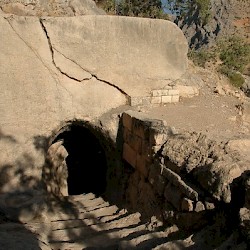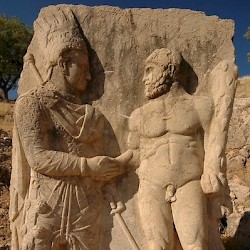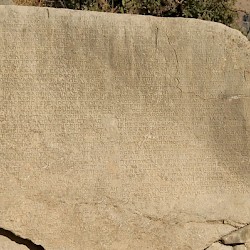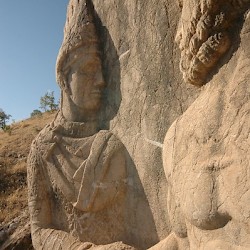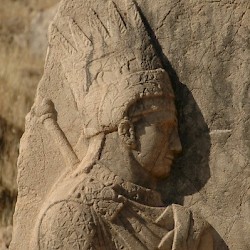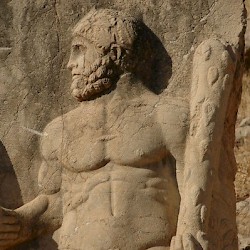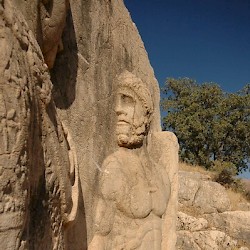Arsameia on the Nymphaios
Q704167Arsamaeia on the Nymphaios: residence of the kings of Commagene, tomb of king Mithridates I Callinicus (r.109-70 BCE). The site is now known as Eski Kale, "the old castle".
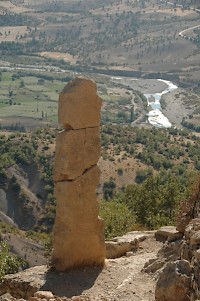
According to the long inscription on the place now known as “site 3”, Arsameia was founded by king Arsames, who had ruled in this part of Armenia in the third quarter of the third century BCE and had expanded his influence when the nearby Seleucid Empire was weakened by the Third Syrian War (246-241).note Arsames also built a wall and palaces in Arsameia.
About a century later, when the Seleucid Empire was no longer a threat to the small kingdom of Commagene, a descendant of king Arsames, Mithridates I Callinicus (r.109-70), concluded an alliance with Seleucid king Antiochus VIII Grypus, marrying his daughter Laodice VII. According to the same inscription, their son Antiochus I Theos of Commagene, buried his father in the hierothesion (sacred last resting-place) in Arsameia.
Site 2
An ancient visitor would first have seen the monument that is now called “site 2”: a large relief of king Antiochus I Theos shaking hands with the sun god Mithra, wearing a Phrygian cap and some twigs that were called a barsom. Barsoms were used in purification ceremonies, which may explain why they are shown at the entrance of the sacred site. Only Mithra survives; of his counterpart, Antiochus, only a shoulder has been found. (Monuments with a king and a god shaking hands are called dexiosis.)
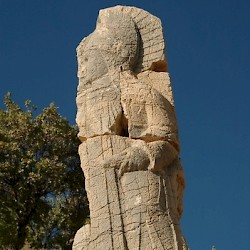 Arsameia, Site 2: Mithras with a Phrygian cap |
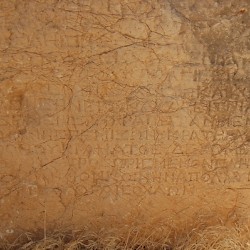 Arsameia, Site 2: Inscription |
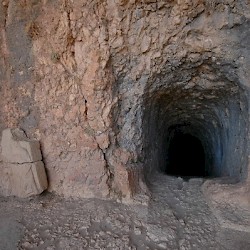 Arsameia, Site 1: relief and tunnel |
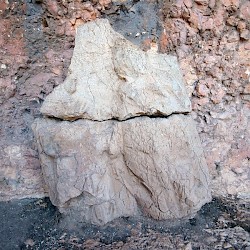 Arsameia, Site 1: Relief of a dexiosis scene |
Site1
Climbing the hill, a visitor reached “site 1”. Here were some caves, used by humans in Prehistoric times, and an artificial cave, a cube-shaped room almost ten meters long, wide, and high. At the entrance (photo above) was a relief of an unidentified king shaking hands with Mithra, who can be identified because of his solar rays. This underground chamber may be the funeral chamber of king Mithridates Callinicus, although it can also have been a cult room for Mithra (a mithraeum). At this place, several unidentified reliefs and inscriptions have been found as well (photos below).
 Arsameia, Unidentified Monument |
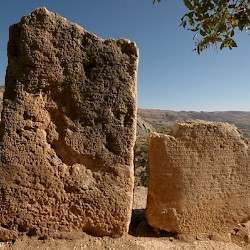 Arsameia, Unidentified Monument, back |
 Arsameia, Unidentified Monument, back, inscription |
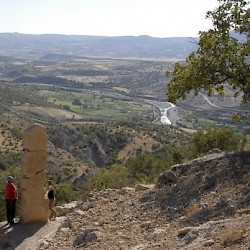 Arsameia, Site 2 and Nymphaios |
Site 3
The most splendid and best-known relief was found at “site 3”: king Mithridates, wearing his state robes and kitaris (an Armenian crown) is shown shaking hands with a naked Heracles. This dexiosis relief is perfectly preserved. Next to it is a very long inscription in five columns, which summarizes the history of the town, offers instructions for the rituals that had to be performed, and sums of the titles of
the great king Antiochus, god, righteous, Epiphanes, friend of the Romans, Philhellene, son of king Mithridates Callinicus and queen Laodice, the daughter of Antiochus.
The inscription is above the entrance to a tunnel that is almost 160 meters long and leads to nowehere. Its purpose is unclear. From site 3, one can proceed further uphill.
Palaces
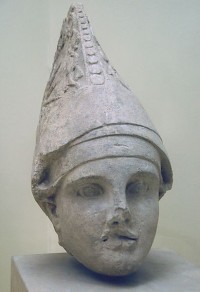
On the summit of the hill, some mosaics from the second century BCE have been found. The architectural remains are hard to identify, but a peristyle can be discerned, suggesting that this was part of a large mansion or palace. Portraits of king Antiochus I Theos and his mother, Laodice, were also found. Perhaps, one of the other monuments was a mausoleum.
On the other side of the river Nymphaios was the royal palace, residence of the kings of Commagene. There are no visible remains, because there is a Mamluk castle on the site, built by Caliph Qalawun (r.1279-1290) during the final stage of the Crusades. It is now called Yeni Kale, the "new castle", to distinguish it from Arsameia, which is called Eski Kale, the "old castle".
Arsameia must have remained in use as long as Commagene existed, which means until the reign of Roman emperor Vespasian, who added the old kingdom to the Roman Empire in 72 CE. The site was abandoned soon after: legionaries of XVI Flavia Firma used the remains of the ancient town as quarry when they were building the bridge at Cendere.
